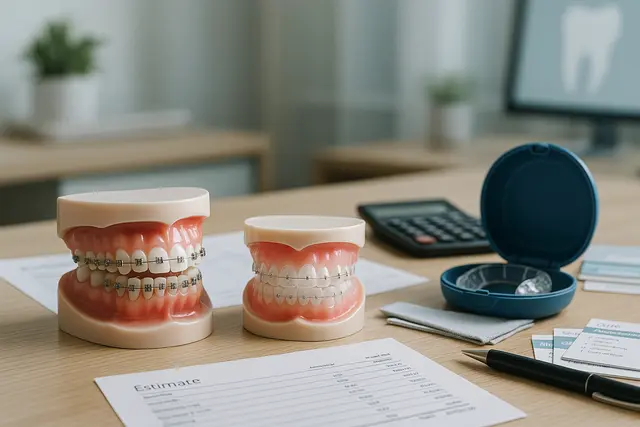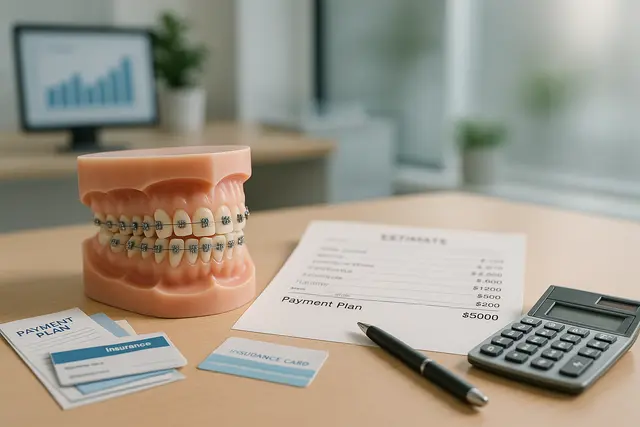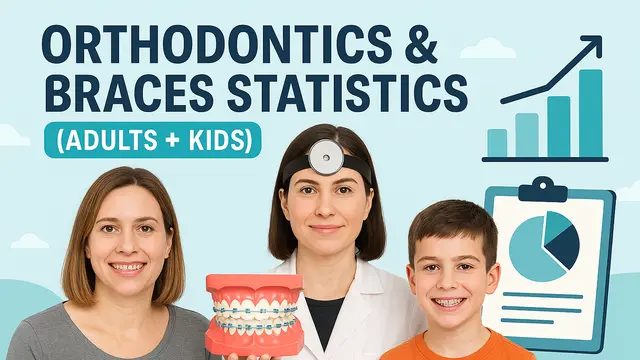Orthodontics
7 min read
Apr 03, 2025
Braces Treatment Timeline: From Consultation to Retainer
Braces treatment is a structured process designed to correct misaligned teeth and improve both function and aesthetics. It begins with a comprehensive orthodontic evaluation and extends through several defined stages, each with specific goals and protocols. While individual experiences vary, the overall timeline, from consultation to retainer use, follows a general path shaped by the complexity of the case, patient compliance, and the chosen treatment method.

Timeline: Snapshot of Your Future Smile
The timeline for straightening teeth looks a lot like planning a cross‑country road trip: you map the entire route before you leave the driveway, then check landmarks along the way to be sure you are still heading toward that final grin.
At your very first visit, the orthodontist studies photos, X‑rays, and digital scans, spots any orthodontic issues such as misaligned teeth or a stubborn overbite, then sketches a personalized treatment plan that answers the question everybody asks: how long you’ll need to wear braces or aligners before you can flash that confident, brace‑free grin.
Orthodontic Journey: Embarking on Orthodontic Treatment with Confidence
Embarking on orthodontic treatment feels less scary once you know the steps. The team explains every orthodontic appliance involved, from the tiny brackets and wires to high‑tech scanners that build a 3‑D model of your bite. You get a clear sense of the treatment process, the average treatment time, and how progress checks keep the treatment on schedule. By the end of the appointment, most patients are considering braces with genuine excitement rather than dread.
Need Braces? Spotting the Telltale Signs
Unsure whether you need braces? Common clues include crooked teeth, gaps that look roomy enough for spare change, or jaw joints that pop and click during meals. If you catch yourself hiding your smile in photos, that’s another hint. Braces are a common orthodontic solution because braces can help guide teeth into healthy positions, trimming long‑term wear on enamel and relieving headaches linked to poor alignment. A simple consult answers the need for braces question once and for all.
Type of Braces: From Traditional Metal to Lingual Wonders
Today’s orthodontic menu offers more than traditional metal braces, although they remain the most common option because they are tough, efficient, and budget friendly. Ceramic braces may tempt style‑focused teens who like brackets that blend with tooth color. Clear ceramic braces use a translucent material that hides in photos, while self‑ligating braces swap elastic ties for clever clips that reduce friction.
Lingual braces live on the tongue side of your teeth, making them invisible during selfies. Each treatment option works toward the same goal but fits different lifestyles.
Braces Treatment: Crafting a Personalized Treatment Plan
No two mouths are identical, so your orthodontist will create a personalized treatment plan tailored to your bite. The plan explains which type of braces best tackles your orthodontic issues, lays out the treatment timeline in months, and lists every check‑up where tiny tweaks keep movement smooth. Think of the document as a GPS for your orthodontic journey; follow it closely and you arrive on time, take shortcuts, and you may need treatment extensions later.
Braces Work: How Brackets and Wires Apply Gentle Pressure on Your Teeth
Ever wonder how braces work effectively without feeling like medieval torture devices? Those brackets act like miniature door handles glued to each tooth, while a flexible archwire supplies steady pressure on your teeth. As the wire tries to return to its original shape, it nudges teeth along planned paths. Tiny adjustments at each visit let the doctor progress and make course corrections so that movement stays comfortable yet steady.
Braces Take: Understanding What Affects Treatment Time
How much time for braces? That depends on several factors. Severity of crowding, patient age, bone metabolism, and whether you wear rubber bands exactly as instructed all influence how long the adventure lasts. Minor crowding can wrap up in a single school year, while complex bites with impacted canines may require more time. The cost of braces can vary too, mostly because longer cases need extra appointments and supplies.
How Long Do Braces Take? Answering the Classic Question
Patients still ask, “How Long do braces take?” in the exact same words, often with hopeful puppy‑dog eyes. The truthful answer: braces typically ranges from 12 to 30 months. The average sits near 18 months, but treatment varies. Remember, braces can vary depending on biology and effort. Wearing elastics overnight and skipping foods that can damage braces, or make brackets pop off, can shave weeks off the schedule.
Treatment Time: Keeping Your Treatment on Schedule
Orthodontists call six‑week visits “tightening,” but they are really quick status updates. At each session, new wires keep pressure on your teeth gentle yet relentless. Skipping appointments stretches the duration of treatment because teeth drift when unattended. If you are wondering how long your teen will need to wear braces, focus on punctual visits and perfect elastic wear; treatment time shrinks when everybody sticks to the script.
Treatment Timeline: Milestones from Consultation to Retainer
Your treatment timeline includes five major markers. First, the consultation and digital scans. Second, bonding day when you get braces and clear aligners are reviewed as future options. Third, periodic wire changes and monitoring of orthotropic growth for younger patients. Fourth, finishing wires fine‑tune your bite until it feels like the teeth and braces were handmade to fit each other. Fifth, the grand finale: debonding and retainer delivery.
Treatment Duration: Why One Size Never Fits All
Duration of your treatment hinges on individual variables: genetics, oral hygiene, and whether a jaw surgery partner is part of the braces treatment timeline. For adults, bone moves a bit slower, so treatment can help but may require extra months. Kids sport faster bone turnover, yet their sweet tooth for caramel apples threatens to damage your braces and extend weeks into months. Factors influence how long, but diligent care keeps the finish line in sight.
Duration of Braces Treatment: Factors Influence How Long
Several factors influence how long the length of your braces treatment lasts. Severe rotations require stronger wires and longer holding phases. Lingual braces need extra chair time because adjustments occur on the tongue side, yet they deliver stealth straightening. Self‑ligating brackets claim reduced friction, so some cases wrap sooner. Still, treatment depends on biology more than branding. Your orthodontist monitors tissue response to be sure pressure stays gentle.
Braces Timeline: Progress and Make Adjustments
At every visit, orthodontists record how far teeth have traveled and compare that number with the projected braces timeline on your chart. If movement lags, they switch to a stiffer wire. If teeth sprint ahead, lighter wires prevent root resorption. These measured tweaks ensure successful treatment without surprises. You can track progress too: snap monthly selfies and watch the crooked teeth transform into a postcard‑perfect arch.
Influence How Long: Lifestyle Choices that Extend or Shorten Your Plan
Chewing ice cubes, chomping pens, or skipping floss can snap wires and influence how long your braces ride lasts. Foods can damage your braces, think caramel, hard nuts, and popcorn kernels hiding like dental ninjas. Protect your braces with a mouthguard during sports and you avoid emergency trips that add weeks. Small habits either speed the journey or throw speed bumps under your wheels.
Remove Your Braces: The Big Day and What Follows
When brackets finally come off, the room usually erupts in cheers. But you are not done yet. Right after the doctor remove your braces, molds for retainers happen so your teeth do not backslide. Retention is part of the braces life cycle; a retainer holds alignment while bone firms up. Skip wear and the time you need to wear braces feels wasted as teeth relapse.
Benefits of Braces: Beyond Straight Teeth
Straight teeth look sharp in selfies, but benefits of braces reach deeper. Aligned arches make brushing simpler, reducing cavities. A balanced bite distributes pressure on your teeth evenly, easing jaw strain. Clear speech improves once tongue space widens. Parents often notice teens who used to whisper suddenly beam with confidence. Successful treatment touches social, emotional, and dental health all at once.
Getting Your Braces: The First Day Survival Guide
Getting your braces inset is quicker than most haircuts. Teeth are polished, brackets placed, and an archwire threaded in under an hour. Mild soreness that night signals that braces work by applying gentle pressure on your teeth, like a gym workout for your roots. Cold drinks soothe discomfort, and wax cushions any rubbing spots. Within days, you forget you are wearing glittery hardware.
Take the First Step: Booking Your Consultation Today
If you have questions about braces, are considering orthodontic treatment, or keep Googling “explore the braces that fit my lifestyle,” call an orthodontist. During the visit, you will discuss different types of braces, review cost numbers, remember, cost of braces can vary, and outline a treatment plan tailored to your goals. Take the first step now, and next year’s holiday photos could show a grin as bright as the lights on the tree.
Adhering to Treatment: Protect Your Braces and Stay on Track
The length of treatment shortens when patients stick to instructions. That means brushing after meals, avoiding foods that can damage braces, wearing elastics faithfully, and showing up on time. Adhering to treatment is the secret sauce that keeps the timeline and what to expect predictable. In return, the doctor can promise a finish date and hand you a retainer rather than an apologetic extension slip.
How Long Do Braces Typically Take to Straighten Teeth?
Most people wear braces between 12 and 30 months, with the average treatment time around 18 months. The exact duration depends on factors like age, case complexity, and how well you follow your orthodontist’s instructions, especially with rubber bands and appointments.
What Affects the Length of My Braces Treatment?
Treatment time is influenced by how severe your misalignment is, your age, your oral hygiene habits, and your lifestyle. Damaged brackets, skipped visits, or poor elastic wear can add weeks or months, while good habits can help shorten the timeline.
What Happens at Each Orthodontic Appointment?
During checkups, your orthodontist evaluates your tooth movement and may change wires or add accessories to keep things on track. These small adjustments guide teeth into position gradually and ensure that your braces treatment stays aligned with your personalized plan.
What Should I Expect After My Braces Come Off?
Once your braces are removed, your orthodontist will take molds for a retainer to keep your teeth in place. Wearing your retainer as instructed is essential, otherwise, your teeth may shift back and undo the progress made during treatment.
Read Next
Related Posts

Orthodontics
Retainer That Looks like Braces: Benefits for Long-Term Alignment
A retainer might not get as much attention as braces, but it plays a crucial role in maintaining your smile after orthodontic treatment. Whether you're new to retainers or curious about the type that looks like braces, understanding their purpose and benefits is key to keeping your teeth aligned for the long haul.
6 min read
Sep 15, 2025

Orthodontics
How Much Are Metal Braces? Cost Comparison With Other Options
Thinking about getting braces but overwhelmed by the cost? You’re not alone. Orthodontic treatment can be a major investment, and understanding the different price points, from metal braces to clear aligners, can help you make a smart, confident decision.
5 min read
Sep 15, 2025

Orthodontics
Orthodontics & Braces Statistics (Adults + Kids)
Orthodontics has transformed from a niche medical service for teenagers into a booming sector that spans all ages. Today, both adults and children seek orthodontic treatment to improve their smiles, fix bite issues, and boost self-confidence.
4 min read
Aug 21, 2025
Don’t have time to research every dentist around you?
See why 30k+ patients trusted us